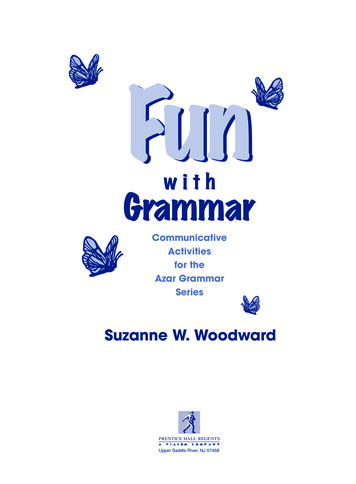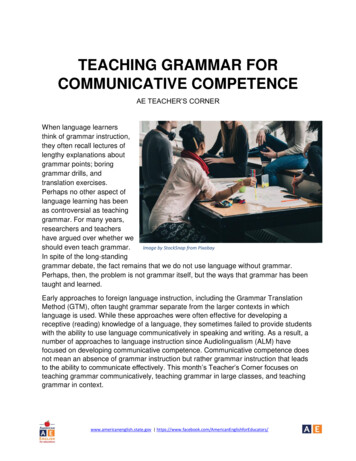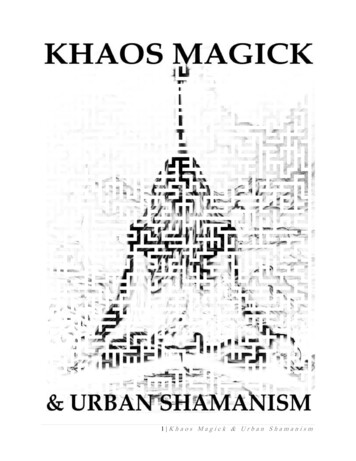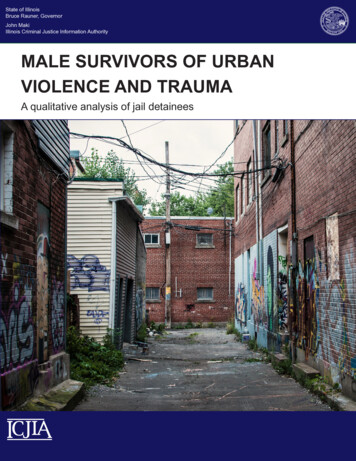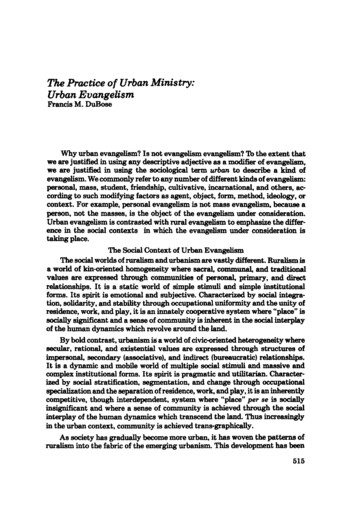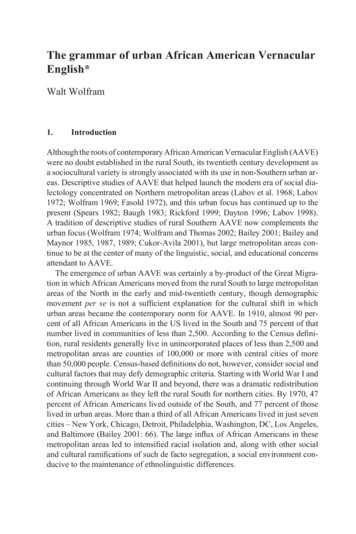
Transcription
The grammar of urban African American VernacularEnglish*Walt Wolfram1.IntroductionAlthough the roots of contemporary African American Vernacular English (AAVE)were no doubt established in the rural South, its twentieth century development asa sociocultural variety is strongly associated with its use in non-Southern urban areas. Descriptive studies of AAVE that helped launch the modern era of social dialectology concentrated on Northern metropolitan areas (Labov et al. 1968; Labov1972; Wolfram 1969; Fasold 1972), and this urban focus has continued up to thepresent (Spears 1982; Baugh 1983; Rickford 1999; Dayton 1996; Labov 1998).A tradition of descriptive studies of rural Southern AAVE now complements theurban focus (Wolfram 1974; Wolfram and Thomas 2002; Bailey 2001; Bailey andMaynor 1985, 1987, 1989; Cukor-Avila 2001), but large metropolitan areas continue to be at the center of many of the linguistic, social, and educational concernsattendant to AAVE.The emergence of urban AAVE was certainly a by-product of the Great Migration in which African Americans moved from the rural South to large metropolitanareas of the North in the early and mid-twentieth century, though demographicmovement per se is not a sufficient explanation for the cultural shift in whichurban areas became the contemporary norm for AAVE. In 1910, almost 90 percent of all African Americans in the US lived in the South and 75 percent of thatnumber lived in communities of less than 2,500. According to the Census definition, rural residents generally live in unincorporated places of less than 2,500 andmetropolitan areas are counties of 100,000 or more with central cities of morethan 50,000 people. Census-based definitions do not, however, consider social andcultural factors that may defy demographic criteria. Starting with World War I andcontinuing through World War II and beyond, there was a dramatic redistributionof African Americans as they left the rural South for northern cities. By 1970, 47percent of African Americans lived outside of the South, and 77 percent of thoselived in urban areas. More than a third of all African Americans lived in just sevencities – New York, Chicago, Detroit, Philadelphia, Washington, DC, Los Angeles,and Baltimore (Bailey 2001: 66). The large influx of African Americans in thesemetropolitan areas led to intensified racial isolation and, along with other socialand cultural ramifications of such de facto segregation, a social environment conducive to the maintenance of ethnolinguistic differences.
112Walt WolframPopulation movement among African Americans has shifted somewhat in thelast several decades, as the influx of Southern in-migrants slowed and more African Americans move from the inner city to suburban areas, but this has hardly affected inner-city segregation. The 2000 US census indicates that approximately 60percent of all African Americans now live in the non-South and that approximately 6 million African Americans live in the large metropolitan centers mentionedabove. Some of these cities have become even more densely populated by AfricanAmericans than they were several decades ago. For example, the city of Detroit isnow 83 percent African American (2000 US Census); in the mid-1960s, when theauthor conducted his fieldwork, it was only 37 percent African American (Wolfram 1969: 21). Furthermore, a half-century ago, the vast majority of middle-agedand elderly African Americans living in Northern urban areas were born in theSouth. In the 1960s, less than 10 percent of African Americans in Detroit over theage of 40 were born in the North; today the majority of African Americans wereborn there or in another metropolitan area. At the turn of the twenty-first century,the population demographics of non-Southern urban areas reveal the continuedexistence of well-established, largely segregated African American populations,especially for those living in poverty.There are several reasons for the earlier and current interest in urban AAVE,ranging from personal and practical reasons to descriptive and theoretical interests. To begin with, most linguists who worked on AAVE in the 1960s livednear Northern metropolitan areas, where the contrast between African Americanspeech and the varieties of the surrounding European Americans was most salient.During the launching period for AAVE studies (Labov et al. 1968; Shuy, Wolfram, and Riley 1967; Wolfram 1969; Fasold 1972), there was also an apparentlink between AAVE and significant social and educational problems in Americansociety, including urban poverty and racial disparity in school performance. Theseproblems were acute in metropolitan areas, where they affected large numbers ofa rapidly growing African American population. In fact, early studies of AAVEsuch as Labov’s landmark study of AAVE in Harlem (Labov et al. 1968) andShuy, Wolfram, and Riley’s study of Detroit speech (1967) were funded by the USOffice of Education because of the concern for an apparent correlation betweenvernacular speech and low educational achievement. Early sociolinguistic studies often addressed prominent educational issues such as literacy and educationalachievement in addition to their focus on dialect description (Labov 1972a; Fasoldand Shuy 1970).As the study of AAVE progressed and encompassed rural Southern varietiesof AAVE (Wolfram 1974; Bailey and Maynor 1985, 1987, 1989; Cukor-Avila2001; Wolfram and Thomas 2002), questions about language change within African American speech emerged, largely subsumed under the divergence hypothesis(Labov 1987; Bailey and Maynor 1989; Poplack 2000; Poplack and Tagliamonte2001). This hypothesis maintains that contemporary AAVE is evolving indepen-
The grammar of urban African American Vernacular English113dently in ways that increase the difference between AAVE and other vernaculardialects of English. The debate over the nature and extent of innovation continues, but most researchers (Bailey and Maynor 1987, 1989; Dayton 1996; Poplack2000; Labov 1998; Poplack and Tagliamonte 2001) agree that the locus of independent innovation within AAVE is largely urban and that change within AAVEis diffusing from urban to rural contexts.The significance of urban versions of AAVE is also connected to the establishment of contemporary language norms related to African American youth culture.Morgan (2001) observes that there is a new urban language ideology that relies,among other behaviors, on the differential use of linguistic features. As Morgan(2001: 205) puts it: “Thus, urban African American life is not simply representedin relation to in-group intersubjectivities, but through cultural symbols and sounds,especially linguistic symbols, which signify membership, role, and status so that( ) words, expressions, messages circulate as commodities”.The center of African American youth culture today is primarily urban, andmany norms and models of behavior, including language, seem to radiate outward from these urban cultural hubs as the norms of contemporary, supraregionalAAVE follow the lead of speakers in these urban areas.2.The construction of urban AAVEHistorically, urban AAVE was established on the basis of transplant dialect communities of Southern rural speakers who moved to non-Southern cities during theearly waves of the Great Migration in the first half of the twentieth century. Therewere patterns of interregional movement in which African American residentsfrom coastal Southern states such as Virginia, the Carolinas, and Georgia tendedto move northward to cities such as Washington, DC, Baltimore, Philadelphia, andNew York and residents of Mississippi, Tennessee, Alabama, and Texas tended tomove to cities such as St. Louis, Chicago, Cleveland, and Detroit, as well as westward to Los Angeles, but most urban neighborhoods were mixed in terms of theirSouthern regional roots. The increasing number of African American in-migrantsin these urban contexts, the shared Southern rural cultural heritage, the segregatedliving conditions, and the bi-racial ideology characteristic of most Northern urbancities certainly provided an ideal context for nurturing ethnolinguistic distinction.The contrast between urban AAVE and the speech of the surrounding EuropeanAmerican cohort communities is hardly at question; there is ample descriptiveand subjective sociolinguistic evidence for this division. The intriguing questionsabout urban AAVE relate to issues of dialect leveling, accommodation, and innovation. To what extent are these urban varieties similar to and different from therural AAVE varieties that were brought to the area originally? Which features oftheir Southern regional founder dialects have been retained and which have been
114Walt Wolframlost? How have these varieties accommodated to the regional dialect forms of thebenchmark European American regional varieties in these urban contexts? Whattypes of linguistic changes now differentiate urban AAVE from its Southern ruralcounterparts? And what is the significance of such differentiation? These are questions that must be addressed in a comprehensive examination of AAVE as it hasdeveloped during the twentieth century. Although most of the discussion of urbanAAVE since the 1980s has centered on the extent to which it shows independentdevelopment and divergence from European American vernaculars (e.g. Labov1987; Bailey and Maynor 1985, 1987, 1989; Dayton 1996), the sociolinguisticconstruction of urban AAVE is much more complex than the issue of independentinnovation within AAVE.There are several different kinds of language change that need to be consideredin the comparison of contemporary urban AAVE and the Southern rural rootsthat provided the founder input (Mufwene 2001). First, there is a kind of dialectleveling in which traditional, localized Southern features may be reduced or lost.For example, in urban Northern AAVE there is no evidence of 3rd plural -s inThe dogs barks even though this trait was a characteristic of some earlier regionalvarieties in the South (Schneider 1989; Montgomery and Fuller 1996; Wolframand Thomas 2002). Similarly, past tense be leveling to weren’t based on polarity(e.g. I weren’t there), a regional trait of earlier African American varieties spokenin the Mid-Atlantic coastal region (Wolfram and Thomas 2002), is not found inNorthern urban AAVE.Earlier, generalized traits of Southern rural AAVE may also be lost, such as aprefixing in She was a-fishin’ or the use of for to complement as in I want for togo now. Although earlier studies of urban AAVE (Labov et al. 1968) recognizedthis type of change, it has become more evident with the expansion of studies ofAAVE in the South (Cukor-Avila 2001; Bailey and Maynor 1985, 1989; Wolframand Thomas 2002).As already noted, change in urban AAVE may also derive from independentlanguage innovation. Studies of be V-ing as a ‘habitual’ marker (Bailey andMaynor 1985, 1987, 1989; Dayton 1996; Rickford 1999; Cukor-Avila 2001) suggest that it is largely an innovation of the post-World War II era and that the changehas spread from an urban locus outward. While independent studies (Bailey andMaynor 1987, 1989) confirm this pattern of innovation and diffusion for habitualbe, the status of other structures, such as the resultative-conditional be done in asentence such as If you leave it in the tub the chicken be done jumped out the tubby the time you get back and narrative marking -s attachment in He goes and sitdown is more disputable (Rickford 1999).One type of sociolinguistic process associated with urban AAVE is linguisticcamouflaging, in which a vernacular form resembles a standard or different vernacular form so closely that it is simply assumed to be identical to its apparentstructural counterpart. However, this similarity may disguise the fact that the form
The grammar of urban African American Vernacular English115carries a distinctive semantic-pragmatic meaning or is constructed in a subtly different way. Spears (1982) shows that the use of a semi-auxiliary come in the sentence They come talking that trash about him seems quite similar to the standardEnglish use of come with movement verbs as in They came running when theyheard the news. Close examination of the use of the come in the former sentence,however, indicates that it fills a unique semantic-pragmatic role indicating speakerindignation. In an analogous way, camouflaging may also involve syntactic expansion based on a shared semantic-pragmatic reading, as in sentences like They callthemselves dancing. While counterfactual call oneself is quite common with nounphrases in most English dialects (e.g. They call themselves linguists) or adjectivephrases (e.g. They call themselves intelligent), its structural expansion to includeV-ing complements sets AAVE apart from most other American English dialects.Some camouflaged structures, especially those involving grammaticalized semantic-pragmatic forms (Spears 1982; Baugh 1984), seem to be characteristic of subtlechanges within urban AAVE, though it is of course possible that these structuressimply may have been overlooked in rural varieties.Thus far, we have discussed urban AAVE only in relation to its change fromSouthern founder dialects and its independent development, but part of its uniqueness may be found in its relationship to surrounding European American varieties.One of the distinctive traits of Northern Urban AAVE appears to be its relativeimmunity to the linguistic changes taking place in cohort white communities. Although this exclusion tends to be more salient in phonology than in morphologyand syntax, a similar pattern of resistance may be found for regional grammaticalpatterns. Many AAVE speakers in Midland dialect regions such as Pittsburgh,Pennsylvania, do not adopt regional morphosyntactic traits such as positive anymore (e.g. We watch a lot of DVDs anymore), need past participle (e.g. The carneeds washed), and 2nd plural youns or yous. Part of the construction of AAVEas an ethnic variety in its urban context is certainly related to its apparent lack ofregional accommodation.Up to this point, we have treated rural and urban AAVE as if it were an obviousbinary distinction, but this does not necessarily match the reality of contemporaryAfrican American culture and language. Such a distinction cannot simply be basedon demographic statistics such as the size of the metropolitan area or populationdensity, as one might be apt to do if relying solely on census data. Furthermore,the distinction between urban and rural may not be as relevant for contemporaryAAVE as it once was. Thus, Cukor-Avila (2001) and Wolfram and Thomas (2002)show that traits formerly associated with urban AAVE are present among youngerAfrican American speakers in remote rural areas of the South. At the same time,African Americans in these regions may be abandoning local regional traits, showing a movement away from local dialect traits as they acquire traits associatedwith urban AAVE. For example, Wolfram and Thomas (2002) show a trajectoryof change in which regional dialect features recede and structures associated with
116Walt Wolframurban AAVE intensify over four generations of speakers in Hyde County, NorthCarolina, a sparsely populated, outlying coastal region of North Carolina. Figure1, an adaptation of the figure given in Wolfram and Thomas (2002: 200), showsan idealized change slope for four generations of speakers divided on the basis ofdifferent sociohistorical periods: speakers who were born and raised in the early twentieth century up through World War I; speakers born and raised betweenWorld War I and school integration in the late 1960s; speakers who lived throughthe early period of school integration as adolescents, and those who were born andraised after integration.Figure 1.Idealized model of change for African Americans in Hyde CountyThe trajectory of change shows that African American speech has shifted ratherdramatically over time, both in its intensification of features associated with urbanAAVE and in its divergence from the local regional dialect norms. Can we trulysay that African Americans in this remote region are now urban when they residein a county inhabited by less than 10 people per square mile and having no publictransit system, no shopping centers or malls, and no fast food stores? Wolfram andThomas (2002) suggests that contemporary AAVE is characterized by a movement towards supraregional AAVE norms and a movement away from, or lackof accommodation to, local regional norms so that the urban-rural distinction isdissipating. At the same time, we recognize that current change is radiating fromurban centers outward. Given the current status of AAVE, the use of the urbanrural distinction in this description must be interpreted in terms of its historical
The grammar of urban African American Vernacular English117context and the current pattern of diffusion within AAVE rather than in terms of astrict, demographically based dichotomy between urban and rural African American populations.3.The grammar of urban AAVEIn this section, I outline some of the major structures of urban AAVE grammar.Given the historical connection to rural varieties of AAVE, the existence of supraregional norms, and current patterns of diffusion, there are many traits of urbanAAVE that are shared with non-urban varieties. In fact, the shared core of AAVEstructures is an essential part of the unique linguistic story of AAVE. Nonetheless,there are ways in which Southern-based, rural and non-Southern, urban varieties differ. In describing the characteristics of urban AAVE in the following sections, I attempt to highlight some of the ways in which contemporary urban AAVEis similar to and different from other varieties, including rural Southern AfricanAmerican and European American varieties, non-Southern vernacular EuropeanAmerican varieties, and standard English. For convenience, the description is organized on the basis of grammatical category.3.1.Verb phraseThe most noteworthy traits of AAVE have typically been associated with the verbphrase, including the use of tense, mood, and aspect. For several decades now, researchers (Fasold 1972; Labov 1972a, 1998; Dayton 1996; Baugh 1983; Rickford1999) have acknowledged that these dimensions distinguish AAVE from othervarieties of English, although there is no consensus on its distinctive aspectual parameters. Although there are a number of distinguishing traits, the most prominentfeatures are a distinct set of preverbal particles or auxiliaries.3.1.1. Copula/auxiliary absenceThe absence of copula and auxiliary for contractible forms of is and are (e.g. Shenice for ‘She’s nice’ or They acting silly for ‘They’re acting silly’) has been oneof the most often described structures of AAVE (e.g. Labov et al. 1968; Wolfram1969; Fasold 1972; Baugh 1983; Rickford 1999). Although there are a numberof descriptive and explanatory dimensions of copula absence that remain in dispute, including whether it is derived through a grammatical or phonological process (Fasold 1976), there is general agreement about its ethnolinguistic status.Wolfram (1974) and Feagin (1979) note that AAVE shares copula absence withsome Southern white rural vernacular varieties of English, but that there are somequalitative and quantitative differences in the respective varieties. Copula absence
118Walt Wolframis quite pervasive in urban AAVE but is not found at all in Northern urban benchmark European American varieties. In Southern European American English varieties, mostly the former large plantation areas, it tends to be limited to forms ofare and used at reduced frequency levels compared to AAVE. Studies of copulaabsence in apparent time and in different regions (Bailey and Maynor 1985, 1987,1989; Cukor-Avila 2001; Wolfram and Thomas 2002) show that the process hasbeen quite stable in AAVE for some time now, and that differences in urban andnon-urban use are quantitative rather than qualitative.3.1.2. Invariant beInvariant be in sentences such as Sometimes they be playing games, also referredto as non-finite be, habitual be, and be2, is probably the most salient grammaticaltrait of AAVE, to the point of becoming a stereotype. Its structural and functionalproperties have now been studied in a number of different urban (Labov 1972a;Labov et al. 1968; Wolfram 1969) and rural settings (Wolfram 1974; Bailey andMaynor 1985, 1989; Cukor-Avila 2001), as well as its development and diffusionover time and place. Although there is disagreement as to how be2 might be represented in the grammatical system of AAVE (e.g. Fasold 1972), most analysesagree that be2 marks a unique aspect referring to an intermittent activity, hence thereference to ‘habitual be.’To begin with, the use of ‘habitual’ be or be2 needs to be distinguished fromseveral other uses of be, including those derived through phonological processesthat affect contracted forms of will and would. In constructions such as She bethere in a minute, the be comes from the loss of /l/ before a labial (she’ll be ‡ shebe) (see Edwards, other volume), whereas in a construction like If they get a DVDplayer they be happy, the form is derived from the loss of /d/ (they’d be ‡ theybe), since /d/ before a labial may geminate to the /b/ and then be lost in a generalphonological process of degemination (e.g. good bye ‡ goob bye ‡goo’bye). Thedifference between the phonologically derived forms, represented in (1) and (2)and the use of be in (3) is readily apparent in tag forms (1a, 2a, 3a) and negatives(2a, 2b, 3b).(1)She be here in a minute.a. She be here in a minute, won’t she?b. She won’t be here in a minute.(2)If they get a DVD player, they be happy.a. If they get a DVD player, they be happy, wouldn’t they?b. If they get a DVD player, they wouldn’t be happy.(3)Sometimes they be playing tag.a. Sometimes they be playing tag, don’t they?b. Sometimes they don’t be playing tag.
The grammar of urban African American Vernacular English119Sentence (3) illustrates the fundamental syntactic and morphological propertiesthat distinguish be2 from its counterpart in other varieties of English; it does notalter its form in finite uses and takes do support in a way that is comparable to mainverbs. Over the last half century, the habitual reference of be, particularly with Ving, has grammaticalized in a change that has been spreading from urban centersoutward. Practically all studies of AAVE show that younger vernacular speakersuse be V-ing more than older speakers (Wolfram 1969; Cukor-Avila 2001; Baileyand Maynor 1987, 1989), and that urban speakers are more likely to use it thannon-urban speakers (Cukor-Avila 2001; Wolfram and Thomas 2002). It is alsopossible that the use of habitual be may be age-graded, and that younger speakerswho use it frequently will reduce its use as they get older, since it now has a strongassociation with black youth culture.A more recent aspectual change is the semantic expansion of invariant be beyond its reference to habituality. Alim (2001), for example, notes that be is commonly used in hip-hop equative sentences such as I be the truth or Dr. Dre be thename in a way that seizes upon its iconic status as a marker of black speech. Under earlier analyses (e.g. Fasold 1972; Wolfram 1969), such stativity would havebeen considered ungrammatical, since it is incompatible with a habitual reading.Dayton (1996) proposes that highly affective utterances such as these may signifyshift towards intensified stativity, or super-real status, rather than habituality. Aswith the original grammaticalization of be V-ing, this most recent change appearsto be taking place in more urban versions of AAVE and spreading outward fromthat point.3.1.3. Completive doneThe use of done with the past tense of the verb, as in They done used all the goodones, is a persistent structural trait of AAVE that is shared with Southern EuropeanAmerican vernacular varieties of English. Although the verbal particle done alsooccurs in Caribbean creoles, its syntactic configuration in AAVE and its semanticpragmatic function differ somewhat from its creole counterparts. In AAVE, doneoccurs only in preverbal auxiliary position with past tense forms whereas it occurswith a bare verb stem (e.g. They done go) and can occur in clause-final positionin some creoles (Holm 1988: 162). In many respects, it functions in AAVE like aperfect, referring to an action completed in the recent past, but it can also be usedto highlight the change of state or to intensify an activity, as in a sentence like Idone told you not to mess up. It is a stable feature, but it is more frequently used inSouthern rural versions of AAVE than in urban AAVE.
120Walt Wolfram3.1.4. Sequential be doneAAVE may also show a combination of be and done together in sentences suchas My ice cream be done melted by the time we get there, marking a resultative ora future conditional state. On one level, this construction seems to function like afuture perfect similar to standard English will have melted in the example givenabove. Dayton (1996) suggests that a newer use of this form functions more likea future resultative-conditional, referring to an inevitable consequence of a general condition or a specific activity, as in a sentence like If you love your enemy,they be done eat you alive in this society. According to Dayton (1996) and Labov(1998), the resultative-conditional meaning, which is often associated pragmatically with threats or warnings, is a newer semantic-aspectual development. Thismeaning, like some of the other nuanced meanings of auxiliaries discussed in thefollowing sections, seems to be characteristic of urban AAVE. Although Dayton(1996) documented numerous examples of this type during her years of participantobservation with AAVE speakers in Philadelphia, it still seems to occur ratherinfrequently in most varieties of AAVE.3.1.5. Remote béenThe stressed use of béen with a past tense form of the verb may denote a specialaspectual function that marks an activity that took place in the distant past. In sentences such as I béen had it for about three years or I béen known him, it refers toan event that took place, literally or figuratively, in a distant time frame. In somecontexts, the form may be interpreted as the deletion of a contracted form of theperfect (e.g. She’s béen married), thus camouflaging some of its subtle semanticdifference from other varieties. For example, Rickford (1975) showed that European Americans and African Americans, when given the stimulus utterance Shebéen married, had quite different responses to the question Is she still married?European Americans interpreted the stressed béen as a deleted perfect form (e.g.,She’s been ‡ She been) and as implying that the referent is no longer married,whereas African Americans interpreted it as a distinctive aspectual marker indicating that the referent had been married a long time. With the exception of thephrase I béen known or I béen knowin’ (phonetically quite similar if not identicalto known [noun]) in casual speech, the use of remote been in urban areas appearsto be receding.3.1.6. Simple past had verbOne of the newer features of AAVE is the narrative use of the auxiliary had witha past or perfect form of the verb (see the section on irregular verbs) to indicatea simple past tense action, as in They had went outside and then they had messed
The grammar of urban African American Vernacular English121up the yard . This use is equivalent to the use of the simple past (e.g. They wentoutside and then they messed up the yard) in Standard English. Whereas earlier descriptions of AAVE (Labov et al. 1968; Fasold and Wolfram 1970; Fasold 1972)do not mention this feature at all, recent descriptions (Cukor-Avila 2001; Rickfordand Théberge-Rafal 1996) observe that this construction may be quite frequent inthe narratives of some preadolescents. Descriptions of AAVE document the narrative use of had verb in both urban (Rickford and Théberge-Rafal 1996) and ruralAAVE settings (Cukor-Avila 2001). The fact that this feature is so frequent amongpreadolescents raises the possibility that it may be age-graded, and that AAVEspeakers will diminish its use as they become adults, although this interpretationis discounted in some of the data from Cukor-Avila (2001). Of course, age-gradingand language change are not necessarily incompatible notions, and it may be thatit is a newer feature that shows some degree of age-grading.3.1.7. Specialized auxiliariesSeveral auxiliaries fill specialized semantic-pragmatic roles that subtly set apartAAVE from other vernacular varieties of English. Among these auxiliary-likeconstructions are the use of come to indicate a state of indignation, the use ofsteady to mark a continuative intensifying activity, and the use of finna to indicatean immediate future or planned event. The use of come with v-ing in the sentenceHe come walkin’ in here like he owned the damn place (Spears 1982: 852) indicates a speaker’s annoyance about the action or event. Structurally, this use closelyresembles the use of come with movement verbs (e.g. She came running) in othervarieties, and is thus a camouflaged form.Another apparent camouflaged form is steady in sentences such as Ricky Bell besteady steppin’ in them number nines (Baugh 1983: 86), where the adverb steadyindicates an intensified, persistent activity. The specialized auxiliary finna in I’mfinna go, related to the generalized Southern form fixin’ to (also fixta, fitna, andfidda), refers to an immediate future or planned event. Camouflaged forms such asindignant come seem to be more recent developments concentrated in urban varieties, although it may be the case that these forms simply have not been noticed inSouthern varieties because of their relative infrequency and structural similarity torelated forms in benchmark European American varieties.At the same time, the use of other au
The grammar of urban African American Vernacular English* Walt Wolfram 1. Introduction Although the roots of contemporary African American Vernacular English (AAVE) were no doubt established in the rural South, its twentieth century development as a sociocultural variety is stron





